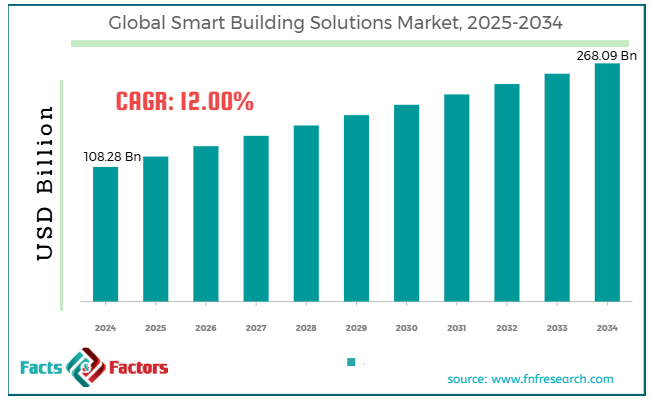Search Market Research Report
Smart Building Solutions Market Size, Share Global Analysis Report, 2025 – 2034

Smart Building Solutions Market Size, Share, Growth Analysis Report By Solutions (Safety & Security Management, Energy Management, Building Infrastructure Management, Network Management, Integrated Workspace Management Systems, And Others), By Services (Support, Maintenance, Implementation, And Consulting), By End-Users (Industrial, Commercial, And Residential), And By Region - Global Industry Insights, Overview, Comprehensive Analysis, Trends, Statistical Research, Market Intelligence, Historical Data and Forecast 2025 – 2034
Industry Insights
[221+ Pages Report] According to Facts & Factors, the global smart building solutions market size was valued at USD 108.28 billion in 2024 and is predicted to surpass USD 268.09 billion by the end of 2034. The smart building solutions industry is expected to grow by a CAGR of 12.00% between 2025 and 2034.

 Market Overview
Market Overview
Smart building solutions involve the integration of advanced technologies with diverse building systems to offer high comfort, energy management, and operational efficiency. These solutions work by automating different processes. There are different components of smart building solutions like automation, safety, building management, data analytics, and many others that attract end-users. These solutions facilitate long-term savings, which further make them popular in the market. These solutions are largely used in industrial, commercial, and residential buildings to facilitate high energy efficiency and security.
 Key Insights
Key Insights
- As per the analysis shared by our research analyst, the global smart building solutions market size is estimated to grow annually at a CAGR of around 12.00% over the forecast period (2025-2034).
- In terms of revenue, the global smart building solutions market size was valued at around USD 108.28 billion in 2024 and is projected to reach USD 268.09 billion by 2034.
- Growing demand for high energy efficiency is driving the growth of the global smart building solutions market.
- Based on the solutions, the safety and security segment is growing at a high rate and is projected to dominate the global market.
- Based on services, the implementation segment is anticipated to grow with the highest CAGR in the global market.
- Based on the end-users, the commercial segment is projected to swipe the largest market share.
- Based on region, North America is expected to dominate the global market during the forecast period
 Growth Drivers
Growth Drivers
- Growing demand for high energy efficiency is driving the growth of the global market.
Smart technologies are gaining popularity in the market because of the rising need to lower overall energy consumption. Moreover, the integration of energy management systems in building solutions is further attracting end-users. Increasing awareness among people regarding the advantages of AI-powered and IoT-enabled devices in the infrastructure is further expected to widen the scope of the industry.
However, the rising trend of co-working and commercial real estate is further expected to propel the growth of the market in the coming years. Real estate developers are exclusively including smart building solutions in their properties to increase the value and attract premium customers. Governments globally are promoting fast adoption of smart building solutions by offering incentives and subsidies, which is further expected to positively influence the growth of the market.
Additionally, there is a rising demand for advanced security solutions like biometric access control or predictive maintenance systems, which are also likely to contribute to the growth of the market.
Moreover, there is a rising trend of promoting sustainable building constructions, which is further likely to propel the growth of the global smart building solutions market.
For instance, Legrand collaborated with URC in 2022 to extend the functioning of Smart Home Control. This partnership is expected to help both companies walk together and offer support to the company's vantage lighting and climate systems.
 Restraints
Restraints
- Financial investment is expected to hinder the growth of the global market.
Smart building solutions are quite expensive and therefore are a barrier for budget-constrained organizations. Also, small and medium-sized residential building owners find it difficult to implement these solutions with high upfront costs. Moreover, integrating these solutions into the existing systems further creates complexities in the smart building solutions industry.
 Opportunities
Opportunities
- Rising trend of flexible workspaces is expected to foster growth opportunities in the global market.
The growing adoption of mixed work models like hybrid and co-working spaces is a leading reason for the high growth rate of the global smart building solutions market. Smart building solutions help organizations better utilize building spaces and overall resources. Also, the growing commercial sectors like retail spaces, hospitality, office buildings, and others are further opening numerous growth opportunities in the industry.
Moreover, developments in data analytics are further expected to improve the overall output of smart building solutions by facilitating advanced data on occupant behavior, building performance, and resource usage. The COVID-19 pandemic has also positively impacted the growth trajectory of the market. People are now increasing their attention on their health, hygiene, and air quality, which is also fostering a strong demand for smart solutions like HVAC systems in the market.
Also, there is a rising adoption of contactless technologies globally, which is further expected to accentuate the growth of the industry. For instance, ABB collaborated with Powrmatic to offer better electrical distribution solutions in Canada in 2024. This partnership is likely to improve the availability of highly reliable electrical solutions across Canada.
 Challenges
Challenges
- Resistance to change is a big challenge in the global market.
There are many regulatory complications and building codes globally, which makes it difficult for organizations to shift toward smart building solutions. Cultural inertia is another major factor resisting the growth of the smart building solutions industry. People are not ready to adopt new technology because of the fear of disruption and lack of familiarity.
 Report Scope
Report Scope
Report Attribute |
Details |
Market Size in 2024 |
USD 108.28 Billion |
Projected Market Size in 2034 |
USD 268.09 Billion |
CAGR Growth Rate |
12.00% CAGR |
Base Year |
2024 |
Forecast Years |
2025-2032 |
Key Market Players |
Telit, Sierra Wireless, Siemens, Schneider Electric SE, Legrand, LG Electronics Inc., KMC Controls, Johnson Controls, INTEL Corporation, Honeywell International Inc., Hitachi Ltd., Emerson Electric Co., Cisco Systems Inc., BOSCH, ABB Ltd., and others. |
Key Segment |
By Solutions, By Services, By End-Users, and Region |
Major Regions Covered |
North America, Europe, Asia Pacific, Latin America, and the Middle East &, Africa |
Purchase Options |
Request customized purchase options to meet your research needs. Explore purchase options |
 Segmentation Analysis
Segmentation Analysis
The global smart building solutions market can be segmented into solutions, services, end-users, and regions.
On the basis of solutions, the market can be segmented into safety & security management, energy management, building infrastructure management, network management, integrated workspace management systems, and others. The safety and security segment will account for the largest share of the smart building solutions industry during the forecast period.
The growing concerns regarding building security are one of the major reasons for the high growth rate of the segment. Increasing incidences of unauthorized access, theft, and other threats are encouraging people to prioritize security systems.
However, smart technologies facilitate real-time monitoring, which helps people have complete control over their properties. Integration of advanced technologies with smart building solutions is further improving the effectiveness of safety and security solutions.
Strict government regulations and building codes are also driving the need for smart solutions. Many end-user sectors like hospitality, retail, and healthcare need to align with the safety standards issued by government authorities, which is further expected to fuel the growth of the segment.
On the basis of services, the market can be segmented into support, maintenance, implementation, and consulting. Implementation is the fastest-growing segment in the global smart building solutions market. The growing demand for customizable solutions is one of the major factors driving the growth of the segment. Organizations are more inclined towards more personalized solutions to align with the regulatory landscape.
Also, there are diverse implementation services like lighting automation, HVAC control, energy management, and security systems. An increasing number of people are adopting smart technologies, which is further fostering high demand for these systems. Implementation services facilitate the seamless integration of advanced technologies like AI and IoT into existing systems.
On the basis of end-users, the market can be segmented into industrial, commercial, and residential. The commercial segment is likely to dominate the smart building solutions industry during the forecast period. Commercial buildings require energy-efficient systems, which lowers their overall energy cost and increases energy efficiency. Smart buildings include automated lighting and energy management systems, which lowers their energy consumption.
Moreover, there is a strong demand for smart technologies in workplaces that promote employee productivity and comfort. Organizations are installing many smart lighting systems, HVAC systems, and other advanced technologies to facilitate higher levels of workspace optimization.
Also, there are strict regulations regarding the usage of commercial spaces, which is expected to contribute to the growth of the segment. Smart building solutions facilitate security like surveillance cameras, biometric access control, and intrusion detection, which are also likely to attract end-users.
Smart security solutions facilitate quick incident responses and real-time monitoring, which is further expected to contribute immensely to the growth of the segment. The growing use of smart building technologies in hospitals and retail sectors is another major factor propelling the growth of the segment.
 Regional Analysis
Regional Analysis
- North America to dominate the global market.
North America is likely to account for the largest share of the global smart building solutions market during the forecast period. The ongoing technological advancements like the inclusion of artificial intelligence and Internet of Things devices are facilitating high growth of the regional market.
Additionally, organizations in the region are increasingly focusing on lowering total energy consumption and overall carbon footprints, which is also facilitating high sales revenue for the industry in the region. HVAC systems, smart lighting solutions, and other energy management devices are gaining immense popularity In the region.
The government in North America is investing heavily in smart city projects, which is another major factor expected to propel the growth of the regional market during the forecast period. The US is the leading market in North America because of the growing focus of people on digital infrastructure. Canada is also expected to see some significant developments in the coming years because of the rising adoption of smart building technologies in the region.
Asia-Pacific is expected to grow significantly in the coming years. China will account for the largest share of the smart building solutions industry during the forecast period. The ongoing smart city initiatives, along with the high urban development in China, are the major reasons for the high growth rate of the regional market.
India is also likely to exhibit high CAGR growth during the forecast period because of the growing government support for the high adoption of smart infrastructure and energy-efficient solutions in the market. APAC is witnessing rapid urbanization, which is fostering a higher demand for intelligent building solutions in the market.
Therefore, all these factors are likely to positively influence the growth trajectory of APAC in the coming years. For instance, Johnson Controls collaborated with Microsoft Beijing Campus in 2022 for the better optimization of the building operations in order to achieve 27.9% energy savings.
 Competitive Analysis
Competitive Analysis
The key players in the global smart building solutions market include:
- Telit
- Sierra Wireless
- Siemens
- Schneider Electric SE
- Legrand
- LG Electronics Inc.
- KMC Controls
- Johnson Controls
- INTEL Corporation
- Honeywell International Inc.
- Hitachi Ltd.
- Emerson Electric Co.
- Cisco Systems Inc.
- BOSCH
- ABB Ltd.
For instance, SeoSiemens collaborated with Prodea Investments in 2024 whose focus is to come up with Smart and sustainable infrastructure in Greece. This partnership will also set new standards for smart building solutions in the Greek market.
The global smart building solutions market is segmented as follows:
 By Solutions Segment Analysis
By Solutions Segment Analysis
- Safety & Security Management
- Energy Management
- Building Infrastructure Management
- Network Management
- Integrated Workspace Management Systems
- Others
 By Services Segment Analysis
By Services Segment Analysis
- Support
- Maintenance
- Implementation
- Consulting
 By End-Users Segment Analysis
By End-Users Segment Analysis
- Industrial
- Commercial
- Residential
 By Regional Segment Analysis
By Regional Segment Analysis
- North America
- The U.S.
- Canada
- Mexico
- Europe
- France
- The UK
- Spain
- Germany
- Italy
- Rest of Europe
- Asia Pacific
- China
- Japan
- India
- Australia
- Southeast Asia
- Rest of Asia Pacific
- The Middle East & Africa
- Saudi Arabia
- UAE
- Egypt
- Kuwait
- South Africa
- Rest of the Middle East & Africa
- Latin America
- Brazil
- Argentina
- Rest of Latin America
Industry Major Market Players
- Telit
- Sierra Wireless
- Siemens
- Schneider Electric SE
- Legrand
- LG Electronics Inc.
- KMC Controls
- Johnson Controls
- INTEL Corporation
- Honeywell International Inc.
- Hitachi Ltd.
- Emerson Electric Co.
- Cisco Systems Inc.
- BOSCH
- ABB Ltd.

Copyright © 2024 - 2025, All Rights Reserved, Facts and Factors


